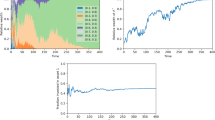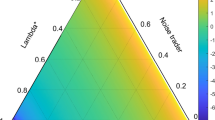Abstract
The purpose of this work is to develop an evolutionary finance model with a risk-free asset playing the role of a numeraire. The model describes a market where one risk-free and several “short-lived” risky assets (securities) are traded in discrete time. The risky securities live one period, yield random payoffs at the end of it, and then are re-born at the beginning of the next period. The main goal of the study is to identify investment strategies that make it possible for an investor to “survive” in the market selection process. It is shown that a strategy of this kind exists, is in a sense asymptotically unique and can be described by a simple explicit formula amenable for quantitative investment analysis.
Similar content being viewed by others
References
Algoet, P.H., Cover, T.M.: Asymptotic optimality and asymptotic equipartition properties of log-optimum investment. Ann. Probab. 16(2), 876–898 (1988)
Amir, R., Evstigneev, I.V., Hens, T., Xu, L.: Evolutionary finance and dynamic games. Math. Financ. Econ. 5, 161–184 (2011)
Amir, R., Evstigneev, I.V., Schenk-Hoppé, K.R.: Asset market games of survival: a synthesis of evolutionary and dynamic games. Ann. Finance 9(2), 121–144 (2013)
Arkin, V.I., Evstigneev, I.V.: Stochastic Models of Control and Economic Dynamics. Academic Press, London (1987)
Bachmann, K.K., De Giorgi, E.G., Hens, T.: Behavioral Finance for Private Banking: From the Art of Advice to the Science of Advice, 2nd edn. Wiley, Hoboken (2018)
Benninga, S., Björk, T., Wiener, Z.: On the use of numeraires in option pricing. J. Deriv. 10, 43–58 (2002)
Björk, T.: Arbitrage Theory in Continuous Time. Oxford University Press, Oxford (1999)
Borch, K.: A utility function derived from a survival game. Manag. Sci. 12, 287–295 (1966)
Bottazzi, G., Dindo, P.: Evolution and market behavior in economics and finance: introduction to the special issue. J. Evolut. Econ. 23, 507–512 (2013a)
Bottazzi, G., Dindo, P.: Selection in asset markets: the good, the bad, and the unknown. J. Evolut. Econ. 23, 641–661 (2013b)
Bottazzi, G., Dindo, P., Giachini, D.: Long-run heterogeneity in an exchange economy with fixed-mix traders. Econ. Theor. 66, 407–447 (2018)
Bottazzi, G., Dosi, G., Rebesco, I.: Institutional architectures and behavioral ecologies in the dynamics of financial markets. J. Math. Econ. 41, 197–228 (2005)
Breiman, L.: Optimal gambling systems for favorable games. In: Proceedings of the Fourth Berkeley Symposium on Mathematical Statistics and Probability, vol. 1, pp. 65–78 (1961)
Brock, A.W., Hommes, C.H., Wagener, F.O.O.: Evolutionary dynamics in markets with many trader types. J. Math. Econ. 41(Special Issue on Evolutionary Finance), 7–42 (2005)
Cabrales, A.: Stochastic replicator dynamics. Int. Econ. Rev. 41, 451–481 (2000)
Cover, T.M.: Shannon and investment. IEEE Information Theory Society Newsletter, Summer, Special Golden Jubilee Issue, pp. 10–11 (1998)
Coury, T., Sciubba, E.: Belief heterogeneity and survival in incomplete markets. Econ. Theor. 49, 37–58 (2012)
Dempster, M.A.H., Evstigneev, I.V., Schenk-Hoppé, K.R.: Volatility-induced financial growth. Quant. Finance 7, 151–160 (2007)
Dynkin, E.B.: Game variant of a problem on optimal stopping. Sov. Math. Dokl. 10, 270–274 (1969)
Evstigneev, I.V., Hens, T., Schenk-Hoppé, K.R.: Evolutionary finance. In: Hens, T., Schenk-Hoppé, K.R. (eds.) Handbook of Financial Markets: Dynamics and Evolution, pp. 507–566. Elsevier, Amsterdam (2009)
Evstigneev, I.V., Hens, T., Schenk-Hoppé, K.R.: Local stability analysis of a stochastic evolutionary financial market model with a risk-free asset. Math. Financ. Econ. 5, 185–202 (2011)
Evstigneev, I.V., Hens, T., Schenk-Hoppé, K.R.: Mathematical Financial Economics: A Basic Introduction. Springer, Berlin (2015)
Evstigneev, I.V., Hens, T., Schenk-Hoppé, K.R.: Evolutionary behavioural finance. In: Haven, E., et al. (eds.) Handbook of Post Crisis Financial Modelling, pp. 214–234. Palgrave MacMillan, London (2016)
Farmer, J.D.: Market force, ecology and evolution. Ind. Corp. Change 11, 895–953 (2002)
Farmer, J.D., Lo, A.W.: Frontiers of finance: evolution and efficient markets. Proc. Natl. Acad. Sci. U. S. A. 96, 9991–9992 (1999)
Foster, D., Young, P.: Stochastic evolutionary game dynamics. Theor. Popul. Biol. 38, 219–232 (1990)
Fudenberg, D., Harris, C.: Evolutionary dynamics with aggregate shocks. J. Econ. Theory 57, 420–441 (1992)
Gale, D.: On optimal development in a multi-sector economy. Rev. Econ. Stud. 34, 1–18 (1967)
Geman, H., El Karoui, N., Rochet, J.C.: Change of numeraire, changes of probability measures and pricing of options. J. Appl. Prob. 32, 443–458 (1995)
Germano, F.: Stochastic evolution of rules for playing finite normal form games. Theor. Decis. 62(4), 311–333 (2007)
Gintis, H.: Game Theory Evolving: A Problem-Centered Introduction to Modeling Strategic Interaction, 2nd edn. Princeton University Press, Princeton (2009)
Hakansson, N.H., Ziemba, W.T.: Capital growth theory. In: Jarrow, R.A., et al. (eds.) Handbooks in Operations Research and Management Science, pp. 65–86. Elsevier, Amsterdam (1995)
Harrison, J., Kreps, J.: Martingales and arbitrage in multiperiod securities markets. J. Econ. Theory 11, 418–443 (1981)
Haurie, A., Zaccour, G., Smeers, Y.: Stochastic equilibrium programming for dynamic oligopolistic markets. J. Optim. Theory Appl. 66, 243–253 (1990)
Hofbauer, J., Sigmund, K.: Evolutionary Games and Population Dynamics. Cambridge University Press, Cambridge (1998)
Karni, E., Schmeidler, D.: Self-preservation as a foundation of rational behavior under risk. J. Econ. Behav. Organ. 7, 71–81 (1986)
Kelly, J.L.: A new interpretation of information rate. Bell Syst. Tech. J. 35(4), 917–926 (1956)
Kifer, Y.: Game options. Finance Stoch. 4, 443–463 (2000)
Kojima, F.: Stability and instability of the unbeatable strategy in dynamic processes. Int. J. Econ. Theory 2, 41–53 (2006)
Kuhn, D., Luenberger, D.G.: Analysis of the rebalancing frequency in log-optimal portfolio selection. Quant. Finance 10, 221–234 (2010)
Latané, H.: Criteria for choice among risky ventures. J. Polit. Econ. 67, 144–155 (1959)
Lintner, J.: The valuation of risk assets and the selection of risky investments in stock portfolios and capital budgets. Rev. Econ. Stat. 47(1), 13–37 (1965)
Lo, A.W.: The adaptive markets hypothesis: market efficiency from an evolutionary perspective. J. Portf. Manag. 30, 15–29 (2004)
Lo, A.W.: Reconciling efficient markets with behavioral finance: the adaptive market hypothesis. J. Invest. Consult. 7, 21–44 (2005)
Lo, A.W.: Adaptive markets and the new world order. Financ. Anal. J. 68, 18–29 (2012)
Lo, A.W.: Adaptive Markets: Financial Evolution at the Speed of Thought. Princeton University Press, Princeton (2017)
Lo, A.W., Orr, H.A., Zhang, R.: The growth of relative wealth and the Kelly criterion. J. Bioecon. 20, 49–67 (2018)
Luenberger, D.: Investment Science. Oxford University Press, New York (1998)
MacLean, L.C., Ziemba, W.T. (eds.): Handbook of the Fundamentals of Financial Decision Making. World Scientific, Singapore (2013)
MacLean, L.C., Thorp, E.O., Ziemba, W.T. (eds.): The Kelly Capital Growth Investment Criterion: Theory and Practice. World Scientific, Singapore (2011)
Markowitz, H.M.: Portfolio selection. J. Finance 7(1), 77–91 (1952)
McKenzie, L.W.: Optimal economic growth, turnpike theorems and comparative dynamics. In: Arrow, K.J., Intrilligator, M.D. (eds.) Handbook of Mathematical Economics III, pp. 1281–1355. North-Holland, Amsterdam (1986)
Milnor, J., Shapley, L.S.: On games of survival. In: Dresher, M., et al. (eds.) Contributions to the Theory of Games III, Annals of Mathematical Studies, vol. 39, pp. 15–45. Princeton University Press, Princeton (1957)
Mossin, J.: Equilibrium in a capital asset market. Econometrica 34(4), 768–783 (1966)
Neyman, A., Sorin, S. (eds.): Stochastic Games and Applications. NATO ASI Series. Kluwer Academic Publishers, Dordrecht (2003)
Nikaido, H.: Convex Structures and Economic Theory. Academic Press, New York (1968)
Samuelson, L.: Evolutionary Games and Equilibrium Selection. MIT Press, Cambridge (1997)
Sciubba, E.: Asymmetric information and survival in financial markets. Econ. Theor. 25, 353–379 (2005)
Sciubba, E.: The evolution of portfolio rules and the capital asset pricing model. Econ. Theor. 29, 123–150 (2006)
Shannon, C.: Lectures on Investment Problems. MIT (unpublished) (see Cover 1998) (1956)
Shapley, L.S.: Stochastic games. Proc. Natl. Acad. Sci. U. S. A. 39, 1095–1100 (1953)
Sharpe, W.F.: Capital asset prices: a theory of market equilibrium under conditions of risk. J. Finance 19(3), 425–442 (1964)
Shiller, R.J.: From efficient markets theory to behavioral finance. J. Econ. Perspect. 17(1), 83–104 (2003)
Shleifer, A.: Inefficient Markets: An Introduction to Behavioral Finance. Oxford University Press, Oxford (2000)
Shubik, M., Thompson, G.: Games of economic survival. Nav. Res. Logist. Q. 6, 111–123 (1959)
Thaler, R.H. (ed.): Advances in Behavioral Finance II. Princeton University Press, Princeton (2005)
Tobin, J.: Liquidity preference as behavior towards risk. Rev. Econ. Stud. 25(2), 65–86 (1958)
Tversky, A., Kahneman, D.: Loss aversion in riskless choice: a reference-dependent model. Q. J. Econ. 106, 1039–1061 (1991)
Vega-Redondo, F.: Evolution, Games, and Economic Behavior. Oxford University Press, Oxford (1996)
Vieille, N.: Two-player stochastic games I: a reduction. Isr. J. Math. 119(1), 55–91 (2000a)
Vieille, N.: Two-player stochastic games II: the case of recursive games. Isr. J. Math. 119(1), 93–126 (2000b)
Vieille, N.: Small perturbations and stochastic games. Isr. J. Math. 119(1), 127–142 (2000c)
Weibull, J.: Evolutionary Game Theory. MIT Press, Cambridge (1995)
Zhang, R., Brennan, T.J., Lo, A.W.: Group selection as behavioral adaptation to systematic risk. PLoS ONE 9, 1–9 (2014)
Ziemba, W.T., Vickson, R.G.: Models of optimal capital accumulation and portfolio selection and the capital growth criterion. In: MacLean, L.C., et al. (eds.) The Kelly Capital Growth Investment Criterion: Theory and Practice, pp. 473–485. World Scientific, Singapore (2011)
Author information
Authors and Affiliations
Corresponding author
Additional information
Publisher's Note
Springer Nature remains neutral with regard to jurisdictional claims in published maps and institutional affiliations.
Financial support from the Swiss National Science Foundation Grant 149856 “Behavioural Financial Markets” (2014–2016) is gratefully acknowledged. The authors are grateful to Rabah Amir and Klaus R. Schenk-Hoppé for helpful comments and fruitful discussions.
Appendix
Appendix
To prove Theorems 1 and 2 we derive a random dynamical system describing the dynamics of the market shares \(r_{t}^{i}\) of the investors \(i=1,\ldots ,N\).
Theorem 3
The following equations hold:
Proof
Put
By using the notation \(A_{t+1,0}=1+\beta _{t+1}\), we write
Define \(\lambda _{t,k}:=(\lambda _{t,k}^{1},\ldots ,\lambda _{t,k}^{N})\) and \(w_{t}:=(w_{t}^{1},\ldots ,w_{t}^{N})\). From (7) and (10) we get
which implies
(see 11). Further, we find
where the first equality holds because \(p_{t,0}=1\), the second follows from (25), and the third is a consequence of (1) and (12). By using (12) and (12), we obtain
Dividing the first and the last terms in this chain of equalities by \(W_{t+1}\) and using (26), we get
Observe that
Further, we have
(\(k=1,\ldots ,K\)) and
[see (18) and (19)]. By substituting (31)–(33) into (30), we arrive at (24).
The proof is complete. \(\square \)
We have shown that the dynamics of the market shares \(r_{t}^{i}\) of the investors \(i=1,2,\ldots ,N\), in the model at hand is governed by the random dynamical system (24). A detailed analysis of this system was carried out in Amir et al. (2013). Theorems 1 and 2 are direct consequences of Theorems 4 and 5 proved in Amir et al. (2013), which we formulate below.
Let \(R_{t,k}(s^{t})\ge 0\) (\(t=0,1,2,\ldots \); \( k=0,\ldots ,K\)) be measurable real-valued functions satisfying (20) and (22). Consider sequences of measurable vector functions \(\Lambda =(\lambda _{t}(s^{t} ))_{t=0}^{\infty }\), where \(\lambda _{t}(s^{t})=(\lambda _{t,0}(s^{t} ),\ldots ,\lambda _{t,K}(s^{t}))\in \Delta ^{K+1}\). Denote by \({\mathcal {L}}\) the set of N-tuples \((\Lambda ^{1},\ldots ,\Lambda ^{N})\) of such sequences for which the random dynamical system (24) generates well-defined vectors \(r_{t}^{i}=(r_{t,0}^{i},\ldots ,r_{t,K}^{i})\in \Delta ^{K+1}\), \(i=1,\ldots ,N\), \(t=0,1,\ldots \), i.e., the validity of the inequality
is guaranteed for each \(t\ge 0\). Define \(\Lambda ^{*}=(\lambda _{t}^{*}(s^{t}))_{t=0}^{\infty }\) by (21).
Theorem 4
For each \((\Lambda ^{1},\ldots ,\Lambda ^{N} )\in {\mathcal {L}}\) with \(\Lambda ^{1}=\Lambda ^{*}\), we have \(\inf _{t\ge 0}r_{t}^{1}>0\) (a.s.).
Theorem 5
Let \(\Lambda =(\lambda _{t}(s^{t}))_{t=0}^{\infty } \) be a sequence of measurable vector functions with values in \(\Delta ^{K+1}\). If \(\inf _{t\ge 0}r_{t}^{1}>0\) for any \((\Lambda ^{1},\ldots ,\Lambda ^{N})\in {\mathcal {L}}\) with \(\Lambda ^{1}=\Lambda \), then (23) holds.
For proofs of Theorems 4 and 5 see Amir et al. (2013, Section 4).
Rights and permissions
About this article
Cite this article
Belkov, S., Evstigneev, I.V. & Hens, T. An evolutionary finance model with a risk-free asset. Ann Finance 16, 593–607 (2020). https://doi.org/10.1007/s10436-020-00370-4
Received:
Accepted:
Published:
Issue Date:
DOI: https://doi.org/10.1007/s10436-020-00370-4




